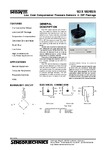Air permeability of balsa core, and its influence on defect formation in resin infused sandwich laminates
| dc.contributor.supervisor | Grove, SM | |
| dc.contributor.author | Cullen, Richard Kingsley | |
| dc.contributor.other | Faculty of Science and Engineering | en_US |
| dc.date.accessioned | 2014-04-25T07:08:16Z | |
| dc.date.available | 2014-04-25T07:08:16Z | |
| dc.date.issued | 2014 | |
| dc.date.issued | 2014 | |
| dc.identifier | 727279 | en_US |
| dc.identifier.uri | http://hdl.handle.net/10026.1/2988 | |
| dc.description.abstract |
Many large composite structures are manufactured using sandwich laminates to achieve high specific bending strength and stiffness. Examples include wind turbine blades, where self-weight becomes increasingly important as blade size increases. Resin infusion of three-dimensional sandwich laminates can result in complex resin flow paths, and subsequent defect formation, which are difficult to predict. The core material used for sandwich construction and its interaction with liquid resins may also influence the formation of defects, and in the case of balsa this effect can be used to reduce defect severity. In order to evaluate the effect of cored sandwich laminate construction on the formation of defects, this thesis concentrates on the characterisation of commonly used core materials and their interaction with liquid resin under high vacuum conditions. It also considers two numerical flow-modelling packages which are shown to be effective at the prediction of flow front convergence for monolithic laminate, but over-estimate defect severity when modelling air- permeable cored laminates. For balsa core, experiments indicate that the available pore space can act as sink for trapped air, which can aid the reduction of defects where multiple flow fronts converge due to the complexity of flow in sandwich laminates. Empirical data for air absorption and desorption rates in balsa core were obtained using a custom-designed experiment. Using these data a theoretical model was developed that can indicate available pore space, which can inform optimum processing conditions, such as time under vacuum. The diffusion coefficients obtained for air absorption and desorption in balsa are very similar, and lie in the middle of published ranges for hard woods at around 2 x 10 -7 m2/s. The methodology developed for this research project represents actual behaviour of air absorption/desorption during resin infusion, whilst other techniques do not, merely measuring diffusion of air through a sample not allowing for finite pore space. In consequence, infusion strategies can be planned more precisely because core/resin interaction is better understood. Knit line defect formation could be predicted with greater accuracy with suitably modified flow-modelling programs. | en_US |
| dc.description.sponsorship | Vestas Technologies, EPSRC | en_US |
| dc.language.iso | en | en_US |
| dc.publisher | Plymouth University | en_US |
| dc.subject | Balsa | en_US |
| dc.subject | Resin Infusion | en_US |
| dc.subject | Sandwich laminate | en_US |
| dc.subject | Defect formation | en_US |
| dc.subject | Permeability | en_US |
| dc.title | Air permeability of balsa core, and its influence on defect formation in resin infused sandwich laminates | en_US |
| dc.type | Thesis | |
| plymouth.version | Full version | en_US |
| dc.identifier.doi | http://dx.doi.org/10.24382/3790 |
Files in this item
This item appears in the following Collection(s)
-
01 Research Theses Main Collection
Research Theses Main



